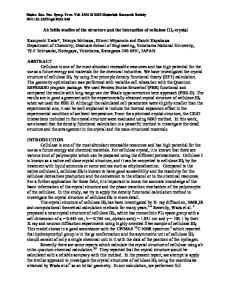Ab Initio DFT Study of Ideal Strength of Crystal and Surfaces in Covalent Systems
- PDF / 1,944,369 Bytes
- 6 Pages / 612 x 792 pts (letter) Page_size
- 29 Downloads / 312 Views
1086-U07-03
Ab initio DFT Study of Ideal Strength of Crystal and Surfaces in Covalent Systems Yoshitaka Umeno Dept. of Fundamental Engineering, Institute of Industrial Science, The University of Tokyo, 4-61 Komaba Meguro-ku, Tokyo, 153-8505, Japan ABSTRACT Ab initio density functional theory (DFT) calculations were performed to examine various factors which may influence the ideal strength, namely multiaxial loading condition and structure with low symmetry. First, the effect of normal stress on the ideal shear strength (ISS) in covalent crystals, Si, C, Ge and SiC, was evaluated. It was found that the response of ISS to normal stress differs depending on the material, while in metals the trend is unchanged. Obtained ISS as a function of normal stress is useful to understand criteria of dislocation nucleation in a pristine crystal because local lattices at the nucleation site undergo superimposed stress components in experiment. Secondly the ideal tensile strength of silicon surface was evaluated to examine how atomistic-level structure affects the mechanical property. The theoretical tensile strength of Si nanofilms with (100) surface, which is flat with dimer-row structures, shows only 20-30% reduction even though the thickness is down to 1 nm, meaning that the flat surface possesses high strength. INTRODUCTION The ideal strength (theoretical strength) is defined as the maximum stress that a perfect crystal can attain (critical stress of instability) under a uniform deformation mode. Since the ideal strength is a fundamental mechanical property of the material and is an important parameter for understanding deformation mechanism, it has been investigated by rigorous theoretical approaches, namely ab initio (first principles) calculations, for various crystals so far. The intrinsic mechanical properties of crystals revealed through these studies by evaluating ideal strength under simple loading -- usually uniaxial stress or strain -- are essential to understand deformation of solids, in particular the criterion of onset of plastic deformation such as dislocation nucleation. Kitamura et al. recently pointed out, however, that various factors affecting critical stress of crystal need to be investigated to bridge the gap between theoretical strength and actual criteria of instability observed in experiment[1]. They suggested to classify the factors into 1) material, 2) loading condition, and 3) structure. While a number of studies on ideal strength have been devoted to elucidate factor 1), contribution to factors 2) and 3) has been limited. Krenn et al. pointed out importance of factor 2) in their analysis of critical shear stress at the onset of plastic deformation observed in a nanoindentation, demonstrating that the effect of compression on critical shear stress is nontrivial. Although theoretical approaches have been dedicated to metallic systems to elucidate the effect of compression on the ideal shear strength, it has not sufficiently been investigated for covalent systems. Significance of examining factor 3) i
Data Loading...











